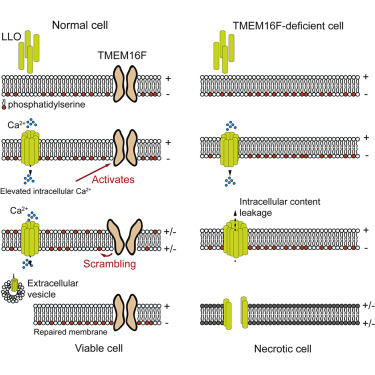Our official English website, www.x-mol.net, welcomes your
feedback! (Note: you will need to create a separate account there.)
Critical Role of Lipid Scramblase TMEM16F in Phosphatidylserine Exposure and Repair of Plasma Membrane after Pore Formation.
Cell Reports ( IF 7.5 ) Pub Date : 2020-01-28 , DOI: 10.1016/j.celrep.2019.12.066
Ning Wu 1 , Vitalij Cernysiov 2 , Dominique Davidson 2 , Hua Song 3 , Jianlong Tang 3 , Shanshan Luo 4 , Yan Lu 2 , Jin Qian 2 , Ivayla E Gyurova 5 , Stephen N Waggoner 6 , Vincent Quoc-Huy Trinh 7 , Romain Cayrol 7 , Ayumu Sugiura 8 , Heidi M McBride 8 , Jean-François Daudelin 9 , Nathalie Labrecque 10 , André Veillette 11
Cell Reports ( IF 7.5 ) Pub Date : 2020-01-28 , DOI: 10.1016/j.celrep.2019.12.066
Ning Wu 1 , Vitalij Cernysiov 2 , Dominique Davidson 2 , Hua Song 3 , Jianlong Tang 3 , Shanshan Luo 4 , Yan Lu 2 , Jin Qian 2 , Ivayla E Gyurova 5 , Stephen N Waggoner 6 , Vincent Quoc-Huy Trinh 7 , Romain Cayrol 7 , Ayumu Sugiura 8 , Heidi M McBride 8 , Jean-François Daudelin 9 , Nathalie Labrecque 10 , André Veillette 11
Affiliation

|
Plasma membrane damage and cell death during processes such as necroptosis and apoptosis result from cues originating intracellularly. However, death caused by pore-forming agents, like bacterial toxins or complement, is due to direct external injury to the plasma membrane. To prevent death, the plasma membrane has an intrinsic repair ability. Here, we found that repair triggered by pore-forming agents involved TMEM16F, a calcium-activated lipid scramblase also mutated in Scott's syndrome. Upon pore formation and the subsequent influx of intracellular calcium, TMEM16F induced rapid "lipid scrambling" in the plasma membrane. This response was accompanied by membrane blebbing, extracellular vesicle release, preserved membrane integrity, and increased cell viability. TMEM16F-deficient mice exhibited compromised control of infection by Listeria monocytogenes associated with a greater sensitivity of neutrophils to the pore-forming Listeria toxin listeriolysin O (LLO). Thus, the lipid scramblase TMEM16F is critical for plasma membrane repair after injury by pore-forming agents.
中文翻译:

脂质扰乱酶 TMEM16F 在磷脂酰丝氨酸暴露和孔形成后质膜修复中的关键作用。
坏死性凋亡和细胞凋亡等过程中的质膜损伤和细胞死亡是源自细胞内的信号的结果。然而,由细菌毒素或补体等成孔剂引起的死亡是由于质膜的直接外部损伤造成的。为了防止死亡,质膜具有内在的修复能力。在这里,我们发现由成孔剂引发的修复涉及 TMEM16F,这是一种钙激活的脂质扰乱酶,也在斯科特综合征中发生突变。在孔形成和随后细胞内钙流入时,TMEM16F 诱导质膜中的快速“脂质扰乱”。这种反应伴随着膜起泡、细胞外囊泡释放、膜完整性的保留和细胞活力的增加。 TMEM16F 缺陷小鼠表现出对单核细胞增生李斯特菌感染的控制受损,这与中性粒细胞对形成孔的李斯特菌毒素李斯特菌溶血素 O (LLO) 的敏感性更高有关。因此,脂质扰乱酶 TMEM16F 对于成孔剂损伤后质膜的修复至关重要。
更新日期:2020-01-29
中文翻译:

脂质扰乱酶 TMEM16F 在磷脂酰丝氨酸暴露和孔形成后质膜修复中的关键作用。
坏死性凋亡和细胞凋亡等过程中的质膜损伤和细胞死亡是源自细胞内的信号的结果。然而,由细菌毒素或补体等成孔剂引起的死亡是由于质膜的直接外部损伤造成的。为了防止死亡,质膜具有内在的修复能力。在这里,我们发现由成孔剂引发的修复涉及 TMEM16F,这是一种钙激活的脂质扰乱酶,也在斯科特综合征中发生突变。在孔形成和随后细胞内钙流入时,TMEM16F 诱导质膜中的快速“脂质扰乱”。这种反应伴随着膜起泡、细胞外囊泡释放、膜完整性的保留和细胞活力的增加。 TMEM16F 缺陷小鼠表现出对单核细胞增生李斯特菌感染的控制受损,这与中性粒细胞对形成孔的李斯特菌毒素李斯特菌溶血素 O (LLO) 的敏感性更高有关。因此,脂质扰乱酶 TMEM16F 对于成孔剂损伤后质膜的修复至关重要。

































 京公网安备 11010802027423号
京公网安备 11010802027423号